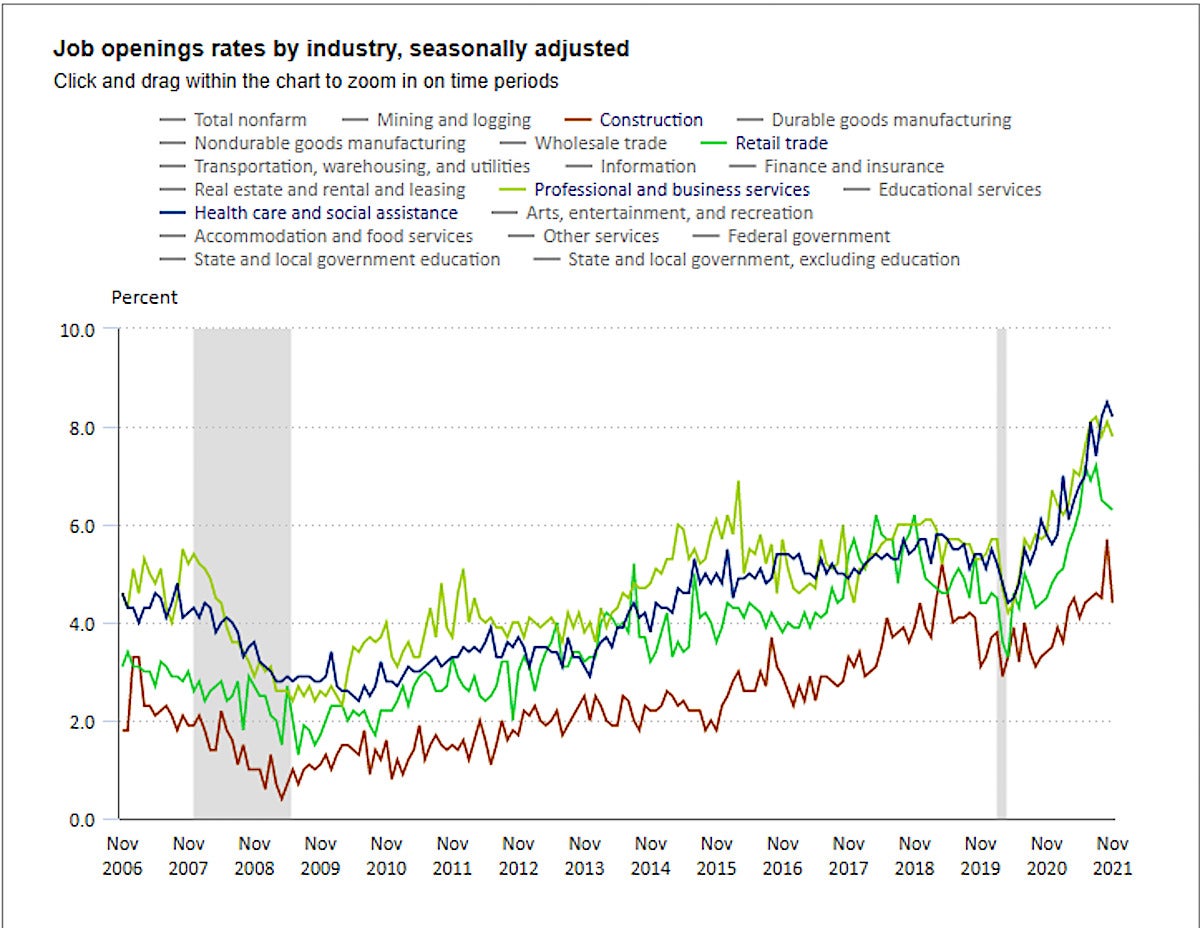A record 4.5 million American workers quit their jobs in November as the “Great Resignation” continues to affect the labor market, according to data released Tuesday by the US Bureau of Labor Statistics. Employee layoffs and firing rates remained unchanged from previous months.
And a new survey released today indicates most are walking out the door in search of better pay and benefits — and may continue to quit in large numbers throughout 2022.
“With a record number of job openings and the rise of remote work, barriers to job switching are now lower than ever,” Kevin Harrington, CEO of employee-search company Joblist, said in a statement. “Employees are taking advantage and demanding higher pay, better benefits, increased flexibility, and more to join and then stay. For 2022, employers need to listen to the market and adapt quickly in order to remain competitive.”
Joblist today released the results of a survey more than 20,000 job seekers from across the United States conducted over the past three months. According to the survey, 74% of full-time employees and 51% of part-time workers sais they’re planning to quit their jobs this year.
In October, 4.1 million US workers quit. That number was down from a previous record 4.4 million who left the workforce in September and 4.3 million in August.
 US Bureau of Labor Statistics
US Bureau of Labor StatisticsThe civilian unemployment rate in the US.
The hospitality and healthcare industries took the biggest hits as workers left to find better wages and benefits. The transportation, warehousing, and utilities industries also saw employee flight in significant numbers.
“Overall, more than two-thirds of all employed workers (68%) say that they plan to leave their current job in the next 12 months,” Joblist said in its report.
Jack Gold, president and principal analyst at J. Gold Associates, said the Joblist results seem far too high and may rely too much on a self-selecting sample of people already on the site searching for a job, meaning they’re not representative of the general population.
“Also, more generally, if it’s blue-collar workers vs. white collar workers or a mix, then it could be skewed,” Gold said. “Turnover is also dependent on the industry. In general, I’ve seen turnover at most companies in white collar jobs in the less than the 15% range.
“And very few people are quitting due to salary alone. Usually it’s more about working conditions (e.g., work/life balance, not liking their managers, not feeling accomplished in their jobs, etc.),” Gold added.
People who feel they are accomplishing something on the job have a fairly high satisfaction level and generally don’t quit, Gold said. For people in low-paying or unskilled jobs, the turnover rate is usually high, and under current conditions where the job market is tight, it’s relatively easy to leave almost any position and get a new one.
 US Bureau of Labor Statistics
US Bureau of Labor StatisticsJob openings rates by industry, seasonally adjusted, from 2006-2021.
In contrast to Joblist’s data, a Gartner survey in October of 3,515 employees showed that 31.4% intend to look for a job with another organization in the next year. While that survey did not ask a comprehensive set of reasons why people want to leave, it did find that safety, vaccination policy, and hybrid work arrangements play a role.
Additionally, Gartner found:
- 16% said they would quit if they had to come into the workplace before they feel it’s safe.
- 14% said they would quit if they have to get vaccinated for COVID-19 as a term of their employment.
- 22% said they would quit if they have to work fully or partially onsite again.
“Thus, people are taking a number of things into account in their decisions to stay or leave jobs,” said Jamie Kohn, director in the Gartner’s HR practice. “Employees are also more confident in job availability than they were pre-pandemic, showing that even those who are not actively looking to leave their jobs know that they have a lot of options out there.”
Pay is a major reason employees are walking out the door, according to Joblist. It found 79% of employed job seekers believe they can make more money switching jobs than staying put.
In a seperate survey of 18,000 employees last year, Gartner found the top drivers of attraction to a new job were:
- Compensation—48%
- Work-life balance—42%
- Location—33%
- Stability—31%
- Respect—29%
(Those figures represent the percentage of employees ranking the attribute in the top five most important.)
“The importance of compensation and work-life balance have gone up since 2020, but this is mostly a return to pre-pandemic levels. Therefore, I would not say compensation itself is more important,” Kohn said. “However, the switching premium has gone up, so people are expecting more money to switch jobs. The switching premium is even higher than it was pre-pandemic. This is particularly true for IT, which clocks in at a switching premium of 15% pay increase.”
 Gartner
GartnerGartner survey on worker pay expectations.
While pay increases were common issues among those surveyed by both Gartner and Joblist, those pay hikes are being eaten up by inflation.
More than half of workers (53%) received a pay raise in 2020. But 58% of those who got a raise said it was 5% or less, failing to keep pace with the 6.8% inflation rate reported in November 2021, the survey found.
Thirty-eight percent of those surveyed by Joblist believe job prospects are better now than at the beginning of 2021, while just 18% think their prospects are worse.
“This is a major improvement from the end of 2020 when just 21% of job seekers thought their job prospects improved and 38% thought they worsened over the course of the year,” Joblist said in its report. “Looking ahead to 2022, 37% of job seekers believe that it will be easier to find a job [this] year than it was in 2021.”
Another factor prompting workers to quit appears to be a sense of professionall stasis. A separate survey by employee management platform provider Lattice in 2021 showed that 43% of respondents felt their career paths had either stalled or slowed to a crawl. That appears to be particularly true for younger employees; 38% of Gen Z workers (born after 1997) are looking for jobs with greater transparency around job path and development, according to the survey.
“People are a company’s most important asset, and the cost of turnover is high,” Lattice CEO Jack Altman said in a statement. “Managers need to prioritize visibility for employees on their career progression, as well as provide the mentorship and tools to help them move forward, to ensure they’re retaining their best talent.”
Remote work remains extremely popular; 61% of all job seekers surveyed by Joblist indicated they are interested in remote work opportunities in 2022. Of those currently working remotely at least part of the time, 45% say they would quit if their employer required full-time in-person work in 2022.
The survey also found employers should reevaluate workplace benefits post-pandemic. Fully 80% of job seekers believe their companies need to re-evaluate the benefits they offer after the pandemic. Sixty-seven percent of job seekers surveyed indicated benefits are more important to them now than before the pandemic, and 54% would even consider taking a lower-paying job with a better benefits package.



